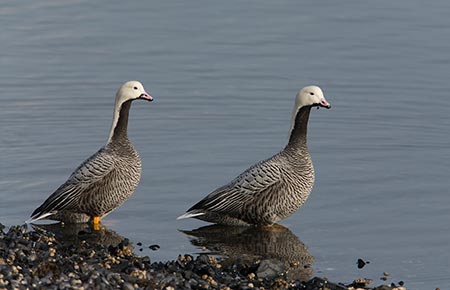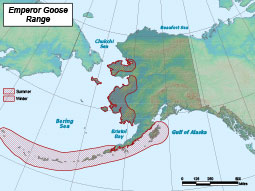Emperor Goose
(Anser canagicus)
Printer Friendly
Did You Know?
Few people ever see an emperor goose. They are an Alaska bird with a limited range in western and Northern Alaska.
General Description
The emperor goose is a relatively small, stocky goose of the north. They weigh about six pounds and are about 26-30 inches (66 – 76 cm) long, with a 48-56-inch (122 – 142 cm) wingspan. They are silvery gray with a white head and hindneck.
Life History
Emperor geese are monogamous breeders and mate for life. Emperor geese do not mate until they are three years old. They nest on the tundra within 10 miles (16 km) of the coast, they tend to lay four or five eggs. Female emperor geese incubate the eggs for about 24 days. Both male and female tend the precocial young, which can fly at about 60 days of age. Mortality can be high for goslings.
Emperor geese eat a variety of marsh plants and berries in summer and fall, in winter they rely on seaweeds, crustaceans, and mollusks. The tend to dabble when feeding, often favoring coastal ponds and marshes.
Lifespan: Up to 25 years in captivity, about 12 years in the wild.
Range and Habitat
The emperor goose is largely endemic to Alaska with a limited range in Western and Northern Alaska, but their range also includes portions of Eastern Russia.
The major nesting grounds for emperor geese are along the coastal fringe of the Yukon-Kuskokwim Delta, with some nesting occurring along coastal areas of Northwest Alaska and eastern Russia. Unlike some arctic-nesting geese that migrate thousands of miles between summer and winter areas, emperor geese migrate a few hundred miles to wintering areas in the Aleutians, along the Alaska Peninsula, and the coast of Kodiak Island. A few stragglers have been found wintering as far south as California and Hawaii.
Status, Trends, and Threats
In 1964, survey counts by the US Fish and Wildlife Service (USFWS) indicated the population was approximately 140,000 birds; these counts declined to 42,000 birds by 1986. The population decline occurred for unknown reasons, but likely due to high adult mortality and periods of low productivity. Subsequent conservation efforts (fall-winter harvest was closed in 1986 and subsistence harvest ceased in 1987) promoted a slow but steady increase to a survey count of 98,000 birds in 2015.
Since harvest closure, the population increased about two percent per year on average. Per the Emperor Goose Management Plan a resumption of harvest could be considered when the most recent three-year average survey count was reached 80,000 birds, as it did in 2015 (81,875 birds). The fall-winter and spring-summer subsistence hunts were resumed in 2017.
Fast Facts
-
Size
About six pounds, length about 26-30, wingspan 48-56-inches. -
Diet
A variety of marsh plants and berries in summer and fall, seaweeds, crustaceans, and mollusks in winter. -
Range
Mostly an Alaska bird with a limited range in Western and Northern Alaska; major nesting grounds are along the coastal fringe of the Yukon-Kuskokwim Delta, with some nesting occurring along coastal areas of Northwest Alaska and eastern Russia.
Did You Know?
- Few people ever see an emperor goose. They are an Alaska bird with a limited range in western and Northern Alaska.
- Emperor geese are rarely found far from marine environments and are sometimes called "beach geese."
- Emperor geese tend to fly low, close to the ground or the water.
- Emperor geese are far less social than other types of geese.
- About ninety percent of the world's population of emperor geese nest on the Yukon-Kuskokwim Delta.
Uses
A permit hunt is authorized for emperor geese in Alaska during the fall-winter period, with a statewide quota of up to 1,000 birds. A permit allows an annual limit of one goose per hunter. A spring-summer subsistence hunt of emperor geese is authorized as a customary and traditional hunt.
Management
Emperor geese are managed by the U.S. Fish and Wildlife Service and the Alaska Department of Fish and Game.
More Resources
General Information
- Geese — Wildlife Notebook Series (PDF 110 kB)
- The Emperor of Geese (Alaska Fish & Wildlife News)
- Alaska Region: Migratory Birds (US Fish & Wildlife Service)
- Pacific Flyway Council Migratory Bird Management


